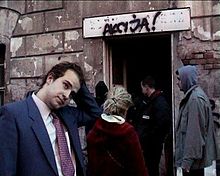Squatting in Serbia
Following World War I, shanty towns emerged in the mostly demolished capital Belgrade, the most notable example being Jatagan Mala.
[3] The reasons for squatting and illegal construction were the lack of affordable housing, bad governance and the bureaucracy involved in legalising land clams.
[4] Squatting has come to refer to either Romani people occupying buildings or shacks built as second homes in suburban areas.
[5] A large Romani settlement called Cardboard city (Serbian: Картон сити, Karton siti) was evicted in 2009.
A former military barracks housing around 1,200 refugees mainly from Afghanistan and Pakistan was then evicted to clear the ground for the Belgrade Waterfront project.

